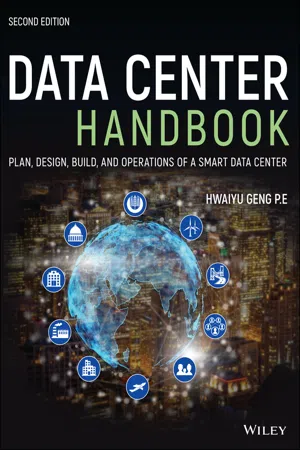
Data Center Handbook
Plan, Design, Build, and Operations of a Smart Data Center
- English
- ePUB (mobile friendly)
- Available on iOS & Android
About this book
Written by 59 experts and reviewed by a seasoned technical advisory board, the Data Center Handbook is a thoroughly revised, one-stop resource that clearly explains the fundamentals, advanced technologies, and best practices used in planning, designing, building and operating a mission-critical, energy-efficient, sustainable data center. This handbook, in its second edition, covers anatomy, ecosystem and taxonomy of data centers that enable the Internet of Things and artificial intelligent ecosystems and encompass the following:
SECTION 1: DATA CENTER OVERVIEW AND STRATEGIC PLANNING
- Megatrends, the IoT, artificial intelligence, 5G network, cloud and edge computing
- Strategic planning forces, location plan, and capacity planning
- Green design & construction guidelines and best practices
- Energy demand, conservation, and sustainability strategies
- Data center financial analysis & risk management
SECTION 2: DATA CENTER TECHNOLOGIES
- Software-defined environment
- Computing, storage, network resource management
- Wireless sensor networks in data centers
- ASHRAE data center guidelines
- Data center telecommunication cabling, BICSI and TIA 942
- Rack-level and server-level cooling
- Corrosion and contamination control
- Energy saving technologies and server design
- Microgrid and data centers
SECTION 3: DATA CENTER DESIGN & CONSTRUCTION
- Data center site selection
- Architecture design: rack floor plan and facility layout
- Mechanical design and cooling technologies
- Electrical design and UPS
- Fire protection
- Structural design
- Reliability engineering
- Computational fluid dynamics
- Project management
SECTION 4: DATA CENTER OPERATIONS TECHNOLOGIES
- Benchmarking metrics and assessment
- Data center infrastructure management
- Data center air management
- Disaster recovery and business continuity management
The Data Center Handbook: Plan, Design, Build, and Operations of a Smart Data Center belongs on the bookshelves of any professionals who work in, with, or around a data center.
Frequently asked questions
- Essential is ideal for learners and professionals who enjoy exploring a wide range of subjects. Access the Essential Library with 800,000+ trusted titles and best-sellers across business, personal growth, and the humanities. Includes unlimited reading time and Standard Read Aloud voice.
- Complete: Perfect for advanced learners and researchers needing full, unrestricted access. Unlock 1.4M+ books across hundreds of subjects, including academic and specialized titles. The Complete Plan also includes advanced features like Premium Read Aloud and Research Assistant.
Please note we cannot support devices running on iOS 13 and Android 7 or earlier. Learn more about using the app.
Information
FOREWORD (1)
FOREWORD (2)
FOREWORD (3)
Table of contents
- COVER
- TABLE OF CONTENTS
- TITLE PAGE
- COPYRIGHT PAGE
- DEDICATION PAGE
- ABOUT THE EDITOR/AUTHOR
- TECHNICAL ADVISORY BOARD
- LIST OF CONTRIBUTORS
- FOREWORD (1)
- FOREWORD (2)
- FOREWORD (3)
- PREFACE DATA CENTER HANDBOOK (SECOND EDITION, 2021)
- PREFACE DATA CENTER HANDBOOK (FIRST EDITION, 2015)
- ACKNOWLEDGEMENTS DATA CENTER HANDBOOK (SECOND EDITION, 2021)
- ACKNOWLEDGMENTS DATA CENTER HANDBOOK (FIRST EDITION, 2015)
- PART I: DATA CENTER OVERVIEW AND STRATEGIC PLANNING
- PART II: DATA CENTER TECHNOLOGIES
- PART III: DATA CENTER DESIGN & CONSTRUCTION
- PART IV: DATA CENTER OPERATIONS MANAGEMENT
- INDEX
- END USER LICENSE AGREEMENT